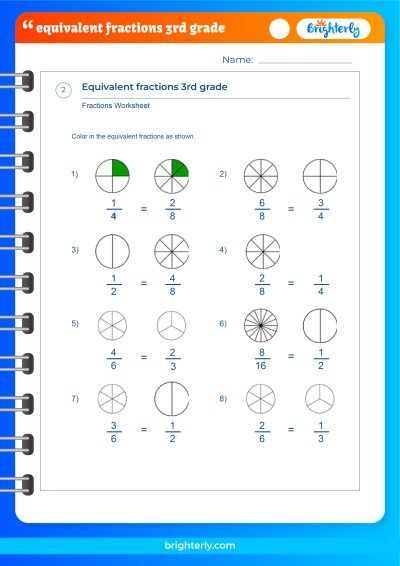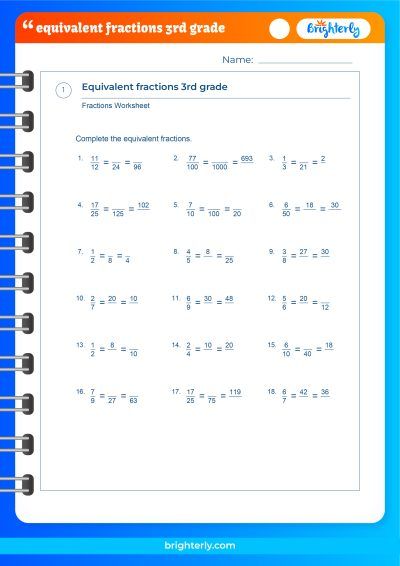Equivalent Fractions – Definition with Examples
Updated on January 14, 2024
Welcome to another exciting exploration of mathematics brought to you by Brighterly, your friendly guide to the fascinating world of numbers. Today, we delve into the intriguing and pivotal concept of equivalent fractions. This foundational math principle is a critical stepping stone to understanding more complex mathematical concepts. For parents and teachers alike, Brighterly brings clarity, making math accessible and enjoyable for every child. In this comprehensive guide, we unpack equivalent fractions, their significance, ways to find them, and how to confirm if two fractions are indeed equivalent. By the end of this, we assure that your child will have a strong understanding of this fundamental math concept, ready to tackle more challenging aspects of fractions.
What are Equivalent Fractions?
In the intriguing world of mathematics, understanding the concept of fractions is essential. One key concept that often puzzles children is the idea of equivalent fractions. In the simplest terms, equivalent fractions are fractions that may look different but represent the same value or proportion of a whole. For example, 1/2, 2/4, 3/6 are all equivalent fractions. Although their numerators (the top numbers) and denominators (the bottom numbers) differ, their fundamental values remain the same. These fractions are like identical twins with different outfits!
How to Find Equivalent Fractions?
Finding equivalent fractions can seem like a daunting task. But, fear not! With a little bit of practice and understanding, it can be as easy as pie! There are several ways to find equivalent fractions. The simplest method is to multiply or divide both the numerator and denominator by the same number. Let’s take the fraction 1/2 as an example. By multiplying both numbers by 2, we get 2/4. Similarly, by multiplying both by 3, we get 3/6. Hence, 2/4 and 3/6 are equivalent to 1/2.
How do you know if Two Fractions are Equivalent?
Determining if two fractions are equivalent can be approached in multiple ways. One common method is to make the denominators the same and compare the numerators. You can also convert the fractions into decimal form or use the cross multiplication method. Visual representation using fraction bars or number lines is another powerful tool in understanding the equivalence of fractions.
If you want to master the topic of Equivalent Fractions better, we recommend that you pay attention to the specialized worksheets of Brighterly.
Equivalent Fractions Chart
An equivalent fractions chart is a useful tool that provides a list of equivalent fractions. It is a visual aid that allows students to quickly and easily find and understand equivalent fractions. For instance, in an equivalent fractions chart, you’ll find that 1/2 equals 2/4, 3/6, 4/8, and so on.
Methods to Determine Equivalent Fractions
From making the denominators the same, finding the decimal form of fractions, to cross multiplication and visual methods, there are various strategies to determine equivalent fractions. Depending on the comfort level and understanding of the student, different methods can be applied.
Practice Questions on Equivalent Fractions
Let’s put our understanding of equivalent fractions to the test with these practice questions:
- What is the equivalent fraction of 1/2? (Hint: Multiply the numerator and the denominator by 2, 3, 4)
- Can you find two fractions that are equivalent to 3/4? (Hint: Multiply the numerator and the denominator by 2, 3)
- Are 5/10 and 1/2 equivalent fractions? (Hint: Try to simplify 5/10)
- Can you find an equivalent fraction for 5/6 by multiplying the numerator and the denominator by 3?
- Are 6/9 and 2/3 equivalent fractions? (Hint: Try simplifying 6/9)
Get the most out of these practice questions by trying to solve them independently. Remember, the more you practice, the easier it gets!
Conclusion
Having journeyed through the vibrant landscape of equivalent fractions, we hope that your understanding of this critical mathematical concept has deepened. At Brighterly, we strive to make learning a rewarding and fun-filled experience, removing the fears and uncertainties often associated with subjects like mathematics. Remember, equivalent fractions, like many mathematical concepts, are everywhere around us, from dividing a pizza to sharing a bag of candies. By understanding equivalent fractions, your child is not just learning math; they are acquiring critical life skills. Keep practicing with Brighterly, where learning and fun go hand in hand. Let’s continue our mathematical adventure together!
Frequently Asked Questions on Equivalent Fractions
At Brighterly, we believe in addressing your concerns and clearing all doubts. Here are answers to some of the most frequently asked questions about equivalent fractions:
What are some real-life examples of equivalent fractions?
In real-life, equivalent fractions are used whenever we divide things into parts. For instance, if you slice a pizza into 4 equal parts, each slice represents 1/4 of the pizza. If you then cut each slice into 2 smaller slices, each smaller slice is now 1/8 of the pizza. But, two smaller slices (2/8) still represent the same amount of pizza as one of the original larger slices (1/4). Therefore, 1/4 and 2/8 are equivalent fractions.
Why are equivalent fractions important?
Understanding equivalent fractions helps in solving more complex mathematical problems, especially those involving adding, subtracting, multiplying, and dividing fractions. Additionally, it assists in comparing fractions and simplifying them, essential skills in math and everyday life.
Do equivalent fractions represent the same value?
Yes, equivalent fractions represent the same part of a whole, even though they may look different. The fractions 1/2, 2/4, 3/6, for example, are all equivalent because they represent the same quantity.
For more information and queries, feel free to explore our other resources or reach out to us. At Brighterly, your child’s understanding is our highest reward.






